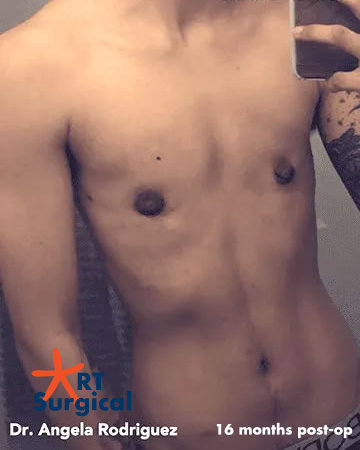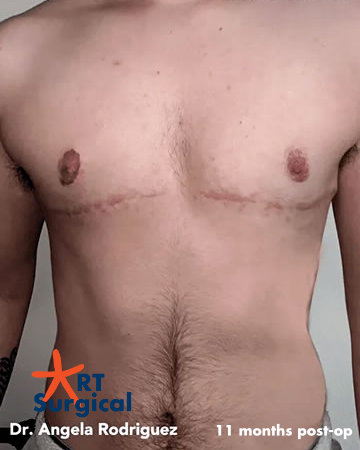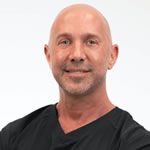FTM Top Surgery
 The Ultimate Top
Surgery Reference Guide
The Ultimate Top
Surgery Reference Guide
- Types of Top Surgery
- Potential Complications
- Who's a Candidate For Top Surgery?
- How To Pay For Top Surgery
- Choosing a Surgeon
- Top Surgery Consultations
- Preparing for Top Surgery
- Recovery - What To Expect
- Top Surgery Results
- Top Surgery Revisions
- Operating Room Videos
What Is FTM Top Surgery?
FTM Top Surgery, or Chest Masculinization, is a gender-affirming procedure that involves the removal of the breasts (Bilateral Mastectomy) and male chest reconstruction to create a masculine-looking chest. Top Surgery is the most commonly performed gender-affirming surgery for trans masculine people and may be the only surgical step taken in a female-to-male transition. Studies have shown that Top Surgery improves psychological and social functioning, helping trans men to live more comfortably.
Types of Top Surgery
There are several different surgical approaches to Top Surgery but the most frequently performed techniques are Double Incision, Buttonhole, Inverted-T, Peri-areolar and Keyhole.
Double Incision involves two horizontal incisions, at the top and bottom of the pectoral muscle. The skin is pulled back and the breast tissue is removed. Nipples are removed, re-sized and grafted back on to the chest. (Nipples are optional though some Surgeons are not comfortable omitting them.) Double Incision is ideal for those who are medium to large chested. With Double Incision, the Surgeon has more control for creating a male contour, nipple size and location. However, the procedure results in larger, more prominent scars than other Top Surgery techniques and limited sensation through the nipple/areola complex (NAC). There's also the potential for Dog Ears if lateral chest wall excision/liposuction isn't performed.
Buttonhole is very similar to Double Incision but preserves nipple sensation and pigmentation. Instead of using nipple grafts, the NAC is re-sized and left attached to the nerves and blood supply, which preserves sensation. A circular incision is made in the chest wall at the appropriate locations for male nipples and the NAC is brought from under the skin through this opening—like a button through a buttonhole—and stitched into place. This approach helps to avoid the extra incisions required by the Inverted-T method. The result is a masculine looking chest with nipples that retain sensation and pigmentation, and have appropriate projection.
Inverted-T is also similar to Double Incision but the NAC is reduced in size and re-positioned via an extra vertical incision that runs from the bottom of the areola to the horizontal incision along the pectoral muscle. Because the nipple stalk and nerve are not severed, the NAC retains its sensation and blood supply, like Buttonhole.
Peri-Areolar is a Top Surgery method that involves two concentric circle incisions that are made all around the border of the areola. The resulting ring of skin around the areola is removed. Breast tissue is then removed and additional contouring using liposuction may be performed. A "drawstring" technique is used to bring the skin together and connect it to the edges of the areola. The areola and/or nipple may be re-sized. Peri-Areolar is ideal for those who are small chested or those who have a B-sized chest and good skin elasticity. Because the nipple stalk and nerve are not severed, sensation is often retained. Scarring is minimal but a revision surgery is commonly required, often related to contour irregularities or areola and/or nipple size.
Keyhole is a Top Surgery technique in which breast tissue is removed via a small incision that's made along the bottom of the areola. The areola isn't re-sized or re-positioned. The nipple can be re-sized. Because of the small incision, scarring is very minimal. The nipple stalk is left intact so sensation is retained. Keyhole is only suited to those who are small chested.


View more Top Surgery results from Dr. Angela Rodriguez »
The key factors to consider when choosing a Top Surgery technique are chest size, amount of excess skin, and desire for nipple sensation.
- Small chest with good skin elasticity: Peri-areolar or Keyhole
- Moderately sized chests (B cup) with good skin elasticity: Peri-areolar, Buttonhole, Double Incision or Inverted-T.
- Large chest or moderately-sized chest with poor elasticity: Buttonhole, Double Incision or Inverted-T.
- Very large chests: Buttonhole, Double Incision.
Top Surgery is a day surgery that is performed in 2-4 hours. General anesthesia is used but patients are rarely catheterized.
Potential Complications
For many individuals, Top Surgery is a necessary step to alleviate gender dysphoria and while serious complications are uncommon, there are risks to be aware of. Potential complications include: bleeding, infection, hematoma, seroma, loss of nipple graft, poor healing of incisions, reaction to anesthesia, changes in pigmentation of the nipple and areola, permanent loss of nipple sensation and contour irregularities. Your Surgeon will explain in detail the risks associated with Top Surgery and you'll be asked to sign a consent form to confirm that you fully understand the potential for complications.
Although breast tissue is removed, there's still a small risk of developing breast cancer after having Top Surgery. Self-exams remain important and those over the age of 40 should have an annual breast exam. If you're BRCA positive, all of the breast tissue should be removed to significantly reduce your risk of developing breast cancer. If breast cancer runs in your family and you haven't taken the BRCA test, speak with your PCP.
Who's a Candidate for Top Surgery?
The WPATH Standards of Care provide clinical guidance for Surgeons to assist transgender and non-binary people with safe and effective treatment. The WPATH Criteria for FTM Top Surgery are:
- Persistent, well-documented gender dysphoria
- Capacity to make a fully informed decision and to consent for treatment
- Be of the age of majority in the country of surgery*
- Significant medical or mental health concerns, if present, must be reasonably well controlled at the time of surgery
*Younger individuals may be considered for Top Surgery if they, their legal guardians, and their mental health professional are all in agreement that Top Surgery is medically appropriate.
Surgeons who follow the Standards of Care will require a letter from a qualified mental health professional stating that Top Surgery is medically necessary for you. Alternatively, and especially if you're paying out-of-pocket for Top Surgery, you could work with a Surgeon who operates on the basis of informed consent. Informed consent is a health care model that allows patients to make decisions about their gender identity and health care. Under informed consent, here's no letter requirement; the patient only needs to possess accurate information and have the cognitive ability to decide about having surgery.
Hormone therapy with Testosterone is not required for having Top Surgery.
How To Pay For Top Surgery
Increasingly, insurance companies are paying for Top Surgery because it's considered a medically necessary procedure. If you have health insurance, read your policy closely or call your insurance company's member services department, or a benefits representative where you work, and ask if your plan covers gender-affirming surgeries. If it does, find out how much the deductible is. When budgeting for Top Surgery, keep in mind that even if you have insurance, you may still be responsible for covering fees associated with liposuction and/or nipple grafts.
Medicare and some state Medicaid plans also cover Top Surgery but finding Surgeons who accept Medicare and Medicaid can be a bit challenging. Surgeons who work at university hospitals are more likely to accept Medicare and Medicaid compared to Surgeons who are in private practice.
If you don't have insurance that covers Top Surgery, you'll need to save up somewhere between $5000-$15,000. The cost of Top Surgery depends on the technique that's used. For example, the Keyhole and Peri-areolar methods tend to be less expensive than Double Incision.
When determining costs, find out if there are any hidden fees you might have to pay for, such as consultation fees, the anesthesiologist's fee, and potentially additional facility fees, pathology fees and other medical test fees. You'll also incur post-operative costs for items such as a compression vest (if your Surgeon doesn't provide one), medications, paper tape, gauze, scar care and more.
A down payment is usually required to secure a surgery date, ranging from $500 - $2000, and up to 50% of the total Top Surgery cost. The total fee must be paid prior to the surgery date.
There are several medical financing companies that offer loans for Top Surgery and among them CareCredit is the best known. Good credit and a minimum monthly income of $1500 is required. Monthly payments for Top Surgery will be in the area of $250-$300. If you can pay off the debt before interest starts accruing, medical financing can be a good way to bridge the gap between your savings and your Top Surgery costs. You can also use CareCredit to pay for deductibles, copays, coinsurance, and other costs that are not covered by insurance.
There are a handful of organizations in the United States that offer grants for Top Surgery. Applying for a grant is one way to top up your Top Surgery savings and get you an earlier surgery date.
Choosing a Surgeon
There's a lot to consider when choosing a Surgeon for Top Surgery. If you have insurance that covers Top Surgery, a good place to start is to call your insurance company, or a benefits rep. where you work, and ask about in-network plastic Surgeons and if your plan has out-of-network benefits.
Identify Top Surgery Surgeons who are located near you. Surgeon location isn't the most important factor in choosing a Surgeon but there are many benefits to working with a Surgeon who's closer to home, especially during recovery. That said, Top Surgery is a specialized procedure with relatively few Surgeons who frequently practice it and you may need to travel to find the best Surgeon for you.
Conduct a search for the Surgeon's name on YouTube and in search engines and see if any videos or patient reviews come up. Patient reviews can be helpful but can also be inaccurate, so take them with a grain of salt. Facebook and Reddit groups can also be a good source for photos of Top Surgery results.
Often overlooked when choosing a Surgeon is credentials. Find license and certification lookup tools and get clear answers about what board certification and other credentials mean here.
Map of Top Surgery Surgeons
Top Surgery Consultations
When you've located a Surgeon that you think might be a good match for you, book a consultation. Many Surgeons offer virtual consultations (via phone/Skype/FaceTime/Zoom) but an in-person consultation is required before the surgery date.
Whether it's a virtual or in-person consultation, be sure to have prepared all of your questions in advance. A good Top Surgery Surgeons will answer questions until you're satisfied. Find a list of questions to ask at a Top Surgery consultation here.
The Surgeon will also have questions for you, regarding your transition, surgery goals, current health, drug allergies, and alcohol, tobacco and drug use. At an in-person consultation, the Surgeon will also examine your chest and take measurements and photos. You can have a support person with you during the consult, if you like.
Preparing For Top Surgery
Even if it's many months away, once you get a surgery date it's time to start getting prepared! Start focusing on eating healthily and getting fit and well-rested. Working on developing the muscles in your chest can help improve results by providing the Surgeon with more contour to work with. Push-ups are your friend!
If you smoke, you'll need to work on quitting as soon as possible. Poor healing and less favorable scars are more common in smokers. Smoking can significantly affect the outcome of Top Surgery because it reduces the amount of oxygen available to cells during healing. Smoking shrinks small blood vessels (vasoconstriction), which reduces the amount of red blood cells (hemoglobin) available to your body and interferes with the release of oxygen (fuel your cells need) to your cells. The narrowing of blood vessels also decreases the blood supply (ischemia) of the tissue, resulting in poor healing, bad scars, or actual loss of tissue. Smoking also reduces the ability of your heart and lungs to recover quickly from the effects of surgery. The use of nicotine gum and patches interferes with healing in the same way as nicotine in cigarettes. Some Surgeons run a nicotine test prior to surgery and will cancel your surgery date if you haven't quit. Surgeons are more varied in their attitudes about cannabis consumption. It's important to be honest with your Surgeon about cannabis use because it can negatively interact with anesthetic drugs.
You'll need to see your PCP for a check-up to be medically cleared for surgery so be sure to book that appointment well ahead of time. If you're over 40, your Surgeon may also require you to have a mammogram before surgery.
Weeks away from surgery, you'll need to stop taking some medications and supplements, and put together your post-op supplies kit.
In the week before you leave for surgery, arrange your living space so that you won't have to reach above your head or bend over for anything you need when you get home. Preparing a week's worth of meals in advance is also recommended.
Recovery - What To Expect
After Top Surgery, you'll wake up in a recovery room where you'll be monitored for any complications. You'll have gauze or bandages on your incisions, as well as a compression vest or elastic bandage around your chest to minimize swelling. These must be kept on at all times, including while sleeping. The compression vest can be removed for showering once you're cleared to do so, but will otherwise stay on for 4-6 weeks. You may also have drains in place to prevent the collection of fluid.
Most of the time, you'll be able to go home, or to wherever you're recovering, the same day as surgery. Before leaving the surgical center, you'll be given specific post-op care instructions that should cover how to care for your incisions, medications, things to look for that could indicate infection, and when you can shower and bathe again.
You'll need assistance from a friend or loved one to go home from the surgical center. You won't be able to carry any luggage after surgery and you'll need someone to drive you home and stay with you for at least 24 hours after discharge.
You'll feel some pain for the first couple of days—especially when you move your upper body around or cough—and discomfort for a week or more. Your Surgeon will prescribe pain medication but Tylenol is often adequate. You'll need a lot of rest during this time.
You'll have at least two follow-up appointments with your Surgeon. The bandages will be removed during your first post-operative visit. Drains are removed at the first or second post-op appointment.
Healing will continue for several weeks, with a reduction in swelling and improvements in mobility. Keep your elbows below shoulder height for at least the first month to avoid stretching your scars. You should be able to return to a desk job within a couple of weeks. If you have a job that requires you to lift heavy objects or move frequently, it may be 6-8 weeks before you can safely return to those activities. Strenuous exercise or lifting more than 10 pounds can usually be resumed after 8 weeks, but ask your Surgeon before doing any chest-focused weight lifting.
As incisions heal, you might experience some itching and shooting pains. It's OK, this is normal healing. Once incisions have closed completely, you can start on scar care. Your Surgeon may have recommendations for scar treatment options. Topical silicone gels, strips and sheets have remained the favored treatment of medical experts in scar management for more than 30 years. Silicone scar care products are reasonably affordable and can be easily obtained at a local drug store or online.
This part is really hard for some people but... Plan to sleep on your back for the first 6 weeks after Top Surgery. Use several pillows to elevate your upper body to reduce swelling.
Top Surgery Results
When it comes to seeing the true results of your Top Surgery, patience is key. Top Surgery results improve considerably with time. It may be 6-12 months before your chest settles into its new shape. Results after 1 year provide a good indication of the results. Results after 2 years will likely have improved, and results after 5 years even more so. With time, scars fade. On Testosterone, hair growth and muscle development can further improve results by helping to hide scars.
When reviewing Top Surgery before and after photos, keep in mind that many of these photos are taken just weeks after surgery. For a better indication of final Top Surgery results, look for photos that are years post-op, not weeks or months.
Top Surgery Revisions
If Top Surgery results need improvement or correction of aesthetic irregularities, a revision surgery can be performed 6-12 months after the original Top Surgery. Top Surgery revisions are fairly common. The common reasons for a revision are contour irregularities, Dog Ears, nipple/areola irregularities, and poor scarring. The cost of a revision depends on your Surgeon's revision policy and the type of anesthesia required (general versus local anesthesia.)
Operating Room Videos
In these videos, Dr. Daniel Medalie, a Top Surgery Surgeon in Cleveland OH, performs Top Surgery using the Double Incision and Peri-Areolar procedures. While this may be too graphic for some, it serves as an important source of information for anyone interested in this procedure.
FTM Top Surgery is a gender-affirming procedure that safely and effectively treats gender dysphoria and helps improve quality of life for trans masculine individuals. Finding out whether or not Top Surgery is right for YOU is a journey that only you can take, but if it is, chances are that, like most trans masculine people, you'll be pleased with the results.
Last updated: 12/01/22

